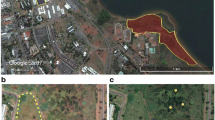Abstract
Theoretical considerations implicate food availability and intrusion pressure as important determinants of territory size, but empirical studies have led to contradictory conclusions about cause-and-effect relationships among these three variables. To investigate this problem, we provided patches of electronically controlled artificial flowers, which were defended by male Calypte anna. Food availability was experimentally manipulated, and intrusion rate and territory size were calculated from behavioral observations of the territory owner. Changes in both food availability and intrusion rate were found to be significantly correlated with changes in territory size under certain conditions. Intrusion rate, which was influenced by food availability, was negatively associated with territory size so long as food availability was high. This association persisted even after possible effects of food availability were controlled statistically. Food availability was negatively correlated with territory size only when intrusion rates were high and after owners had been defending territories for 3 days. As food availability and intrusion rate increased, owners increasingly restricted their defense to the patch itself; partial regressions revealed a significant association for intrusion rate but not food availability. When intrusion rate was low and food availability varied from low to high levels, no relationship was observed between food availability and territory size, apparently because of opposing influences of food abundance on territory size.
Similar content being viewed by others
References
Armstrong DP (1991) Aggressiveness of breeding territorial honeyeaters corresponds to seasonal changes in nectar availability. Behav Ecol Sociobiol 29:103–111
Brown JL, Orians GH (1970) Spacing patterns in mobile animals. Annu Rev Ecol Syst 1:239–262
Carpenter FL (1978) A spectrum of nectar-eater communities. Am Zool 18:809–819
Carpenter FL, Paton DC, Hixon MA (1983) Weight gain and adjustment of feeding territory size in migrant hummingbirds. Proc Natl Acad Sci 80:7259–7263
Charnov ER, Orians GH, Hyatt K (1976) Ecological implications of resource depression. Am Nat 110:247–259
Dill LM (1979) An energy-based model of optimal feeding-territory size. Theor Popul Biol 14:396–429
Ebersole JP (1980) Food density and territory size: An alternative model and a test on the reef fish Eupomacentrus leucosticus. Am Nat 115:492–509
Ewald PW, Bransfield RJ (1987) Territory quality and territorial behavior in two sympatric species of hummingbirds. Behav Ecol Sociobiol 20:285–293
Ewald PW, Carpenter FL (1978) Territorial responses to energy manipulations in the Anna hummingbird. Oecologia 31:277–292
Ewald PW, Orians GH (1983) Effects of resource depression on use of inexpensive and escalated aggressive behavior: experimental tests using Anna hummingbirds. Behav Ecol Sociobiol 12:95–101
Ewald PW, Rohwer SA (1980) Age, coloration and dominance in nonbreeding hummingbirds: a test of the asymmetry hypothesis. Behav Ecol Sociobiol 7:273–279
Gass CL (1979) Territory regulation, tenure, and migration in rufous hummingbirds. Can J Zool 57:914–923
Gass CL, Angehr G, Centa J (1976) Regulation of food supply by feeding territoriality in the rufous hummingbird. Can J Zool 54:2046–2054
Gill FB, Wolf LL (1975) Economics of feeding territoriality in the golden-winged sunbird. Ecology 56:333–345
Hamilton WD (1971) Geometry for the selfish herd. J Theor Biol 31:295–311
Hixon MA (1980) Food production and competitor density as the determinants of feeding territory size. Am Nat 115:510–530
Hixon MA, Carpenter FL, Paton DC (1983) Territory area, flower density, and time budgeting in hummingbirds: an experimental and theoretical analysis. Am Nat 122:366–391
Kodric-Brown A, Brown JH (1978) Influence of economics, interspecific competition and sexual dimorphism on territoriality of migrant rufous hummingbirds. Ecology 59:285–296
Lima SL (1984) Territoriality in variable environments: a simple model. Am Nat 124:641–655
Marchesseault L, Ewald PW (1991) Effect of territory quality on intrusion rate in nonbreeding hummingbirds. Behav Ecol Sociobiol 28:305–308
McFarland DC (1986) Determinants of feeding territoriality in the New Holland honeyeater Phylidonyris novaehollandiae. Emu 86:180–185
McNair JN (1987) The effect of variability on the optimal size of a feeding territory. Am Zool 27:249–258
Myers JP, Connors PG, Pitelka FA (1979a) Territory size in wintering sanderlings: the effects of prey abundance and intruder density. Auk 96:551–561
Myers JP, Connors PG, Pitelka FA (1979b) Optimal territory size and the sanderling: compromises in a variable environment. In: Kamil AC, Sargent TD (eds) Foraging behavior. Garland STPM Press, New York, pp 135–158
Norman MD, Jones GP (1984) Determinants of territory size in the pomacentrid reef fish, Parma victoriae. Oecologia 61:60–69
Norton ME, Arcese P, Ewald PW (1982) Effect of intrusion pressure on territory size in black-chinned hummingbirds. Auk 99:761–764
Paton DC, Carpenter FL (1984) Peripheral foraging by territorial rufous hummingbirds: defense by exploitation. Ecology 65:1808–1819
Pitelka FA (1951) Ecologic overlap and interspecific strife in breeding populations of Anna and Allen hummingbirds. Ecology 32:641–661
Schoener TW (1983) Simple models of optimal feeding-territory size: a reconciliation. Am Nat 121:608–629
Stiles FG (1973) Food supply and the annual cycle of the Anna hummingbird. Univ Calif Publ Zool 97:1–109
Temeles EJ (1987) The relative importance of prey availability and intruder pressure in feeding territory size regulation by harriers, Circus cyaneus. Oecologia 74:286–297
Tricas TC (1989) Determinants of feeding territory size in the corallivorous butterflyfish, Chaetodon multicinctus. Anim Behav 37:830–841
Author information
Authors and Affiliations
Additional information
Correspondence to: P.W. Ewald
Rights and permissions
About this article
Cite this article
Eberhard, J.R., Ewald, P.W. Food availability, intrusion pressure and territory size: an experimental study of Anna's hummingbirds (Calypte anna). Behav Ecol Sociobiol 34, 11–18 (1994). https://doi.org/10.1007/BF00175453
Received:
Accepted:
Issue Date:
DOI: https://doi.org/10.1007/BF00175453




